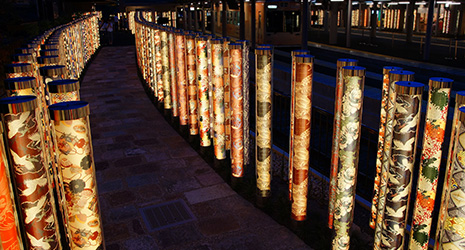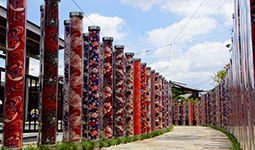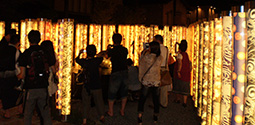July 2022
- English
- 日本語
The Elegant Illuminated “Kimono Forest”

A section of the Kimono Forest at Arashiyama Station illuminated at night 
A Keifuku Arashiyama Line train, also known as “Randen,” arrives at Arashiyama Station

The Ryu-no-atago dragon pond. The name is associated with Tenryu-ji temple, which is located near the station 
The Kimono Forest in the daytime 
People taking pictures in the Kimono Forest at night 
Close-up of the transparent pillars lined with colorful fabrics

The “Kimono Forest” at Arashiyama Station on the Keifuku Arashiyama Line (familiarly known as the Randen) consists of rows of transparent pillars lined with colorful fabrics that have been dyed using the Kyo-yuzen technique for traditional Kyoto kimono. Every evening, when the fabric is backlit with LED lighting so that the patterns emerge out of the darkness, visitors can enjoy an elegant illuminated “wood” that is unique to Kyoto.

Arashiyama is one of the most attractive areas in Kyoto. The scenery created by the Togetsukyo* bridge and the seasonal changes in the mountains never cease to attract visitors from Japan and abroad. Arashiyama Station on the so-called Randen Line is the gateway to the area. The Kimono Forest, which is made to resemble a natural wood, consists of rows of 600 acrylic pillars lined with Kyo-yuzen fabric, and placed along the station platform and the train tracks.
Nishijin-ori, the celebrated fabric for Kyoto kimono, is a woven fabric whereas Kyo-yuzen dyes are applied directly to silk fabric with a brush. Miyazaki Yuzensai, a folding fan painter in Kyoto in the late seventeenth century, is credited with developing the technique when he used his own patterns to dye kimono. The elegant designs are based on traditional themes of natural beauty, and use many colors, creating a gorgeous impression.

Designer Morita Yasumichi arranged the Kyo-yuzen to create the Kimono Forest as a station space design. In the daytime, the impression created is that of a forest of kimono sleeves, but every evening, the station’s appearance is completely transformed when the pillars are illuminated with LED lights. The elegant Kyo-yuzen patterns appear to float in the dark, creating a glamorous and increasingly gorgeous space. Visitors can enjoy the effect of an illumination that is unique to Kyoto and can only be seen here.

The space for the Kimono Forest is the result of two rounds of renovations of Arashiyama Station, in 2002 and 2013, by the Keifuku Electric Railroad in collaboration with Morita Yasumichi.
Suzuki Hiroyuki, who was in charge of the renovation, comments, “Before the station was renovated, Arashiyama was hardly a place that attracted people at night. We wanted to make the station a place that might encourage sightseeing in Arashiyama at night, and this is how we started to work on plans for an illumination at Arashiyama Station.”

In the first stage of renovations in 2002, the station building was refurbished using green bamboo and wood, and the whole building was lit up and finished to a standard that presented visitors with a sense of Japanese-style harmony. During the second stage of the renovations, eleven years later in 2013, the space in the station was opened up and landscaped with paths, a park, and the Ryu-no-atago pond. At this time, the Kimono Forest was conceived as the answer to the challenge of producing an evening attraction for Arashiyama Station.

Suzuki has been touched by the comments of travelers. For example, “It’s as exciting as a visit to a theme park when the train pulls into Arashiyama Station in the evening and the illuminated pillars come into view.” Suzuki adds, “When I hear how much fun people have taking photographs in the illuminated Kimono Forest, and see young people dressed in kimono especially for the visit, I think that the Kimono Forest is becoming established as a new attraction at Arashiyama.” As soon as we can put the Covid-19 period behind us, Suzuki hopes that many people from Japan and abroad will enjoy the Arashiyama scenery in the daytime and the elegant illuminations at night.
* Togetsukyo is a 155-meter-long bridge that crosses the Katsura River, which flows from Sagano to Arashiyama. Upstream from this bridge the Katsura River is known as the Oi River.

